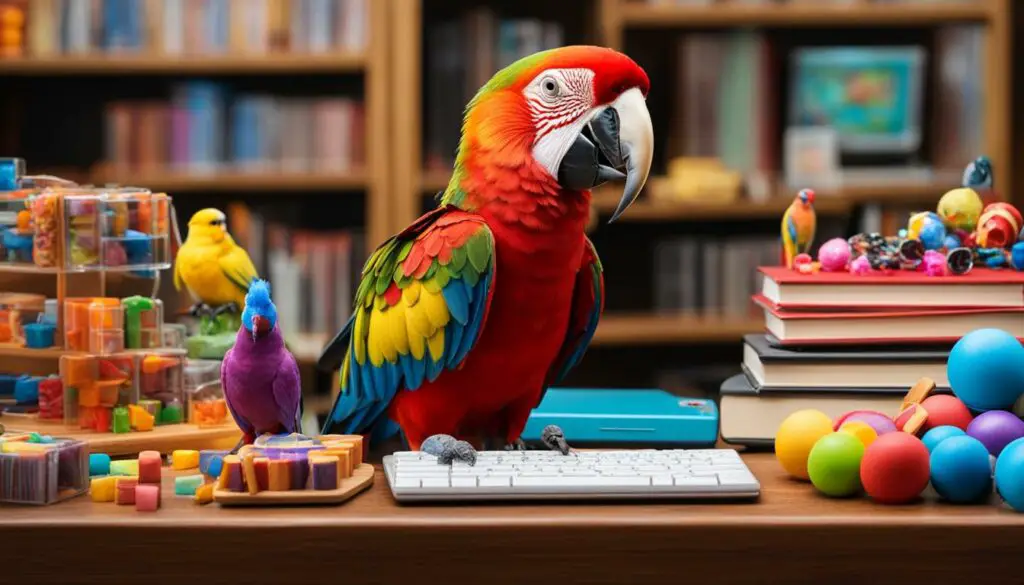Welcome to a comprehensive guide on mastering parrot talking training methods! In this guide, I will take you through step-by-step techniques and strategies to effectively teach your beloved parrot how to talk and communicate with you.
Parrots are incredibly intelligent creatures, capable of learning and mimicking human speech. With patience, consistency, and the right training approach, you can unlock your parrot’s potential and enjoy meaningful conversations with your feathered friend.
Whether you’re a first-time parrot owner or looking to enhance your training skills, this guide is here to help you become a parrot talking training expert. Let’s dive in and discover the best methods for successful parrot communication!
Key Takeaways:
- Mastering parrot talking training methods requires patience and consistency.
- Understanding parrot behavior and communication is crucial for effective training.
- Create a positive training environment with the right supplies and reinforcement techniques.
- Start early and hold frequent training sessions to establish a consistent routine.
- Teach the “step up” command using positive reinforcement and shaping techniques.
Understanding Parrot Behavior and Communication
Before we delve into the world of parrot talking training methods, it is essential to understand the behavior and communication patterns of these intelligent creatures. By interpreting their body language and vocalizations, we can establish a deeper connection and more effective communication during the training process.
Parrots have a wide range of body language cues that convey their emotions, intentions, and needs. For example, a fluffed-up appearance may indicate relaxation or contentment, while rapid tail wagging can signal excitement or agitation. Paying attention to these subtle cues allows us to gauge our parrot’s emotional state and respond accordingly.
Vocalizations are another crucial aspect of parrot communication. These feathered companions are known for their ability to mimic human speech, but they also have a repertoire of unique sounds that they use to express themselves. From cheerful chirps and melodic whistles to loud squawks and screeches, each vocalization carries its own meaning. By learning to decipher these sounds, we can better understand our parrot’s needs and desires.
Interpreting Parrot Body Language
Parrot body language can be categorized into different postures, movements, and actions:
- Fluffed-up feathers: Indicates relaxation or contentment.
- Head bobbing and bowing: Signifies interest or curiosity.
- Wing drooping or twitching: Indicates discomfort or stress.
- Feather ruffling or plucking: Can be a sign of boredom, fear, or health issues.
By observing and understanding these behaviors, we can create a more harmonious and comfortable training environment for our parrots. Remember, clear communication is the foundation for successful parrot talking training.
Vocalization Interpretation
Parrots use vocalizations to express various emotions, needs, and desires. Here are some common examples and their possible meanings:
“Hello!” – A friendly greeting, often used to get attention.
“Step up!” – A command for the parrot to move onto your hand or a perch.
Squawking or screaming – Can indicate excitement, fear, or a call for attention.
Take note of the context in which these vocalizations occur as it can provide valuable insights into your parrot’s current state of mind. With a keen eye and ear, we can become fluent in the language of our feathered companions and establish a stronger bond through effective communication.
Table: Parrot Body Language and Vocalizations
| Body Language | Meaning |
|---|---|
| Fluffed-up feathers | Relaxation or contentment |
| Head bobbing and bowing | Interest or curiosity |
| Wing drooping or twitching | Discomfort or stress |
| Feather ruffling or plucking | Boredom, fear, or health issues |
| Vocalization | Meaning |
| “Hello!” | Friendly greeting, attention-seeking |
| “Step up!” | Command to move onto hand or perch |
| Squawking or screaming | Excitement, fear, or attention-seeking |
Understanding parrot behavior and communication is the foundation for effective training. By recognizing and interpreting their body language and vocalizations, we can establish a deeper bond with our parrots and create a positive learning environment.
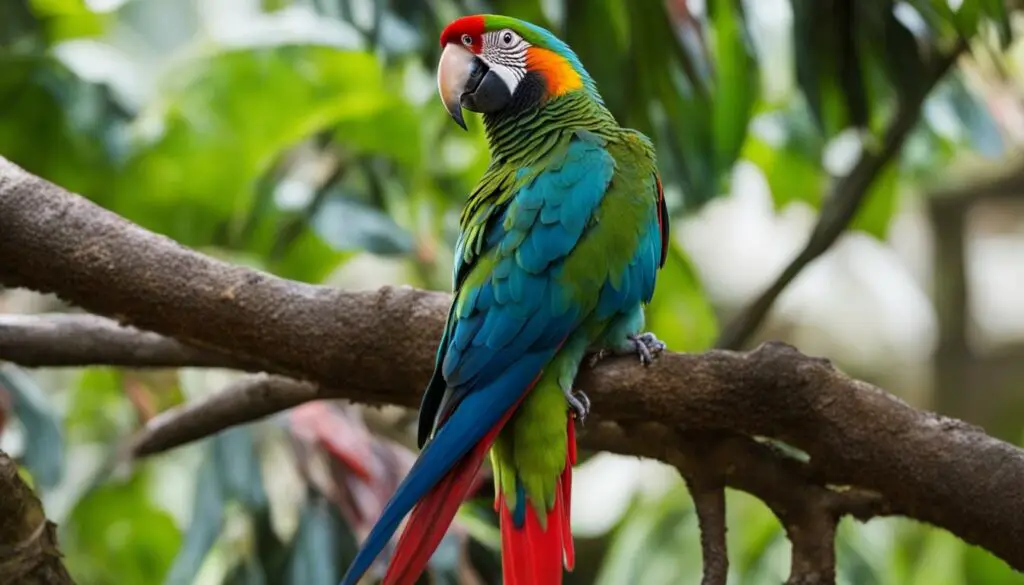
Creating a Positive Training Environment
When it comes to parrot training, creating a positive environment is key to success. By setting up a quiet and comfortable space, you provide your parrot with the right conditions for learning and growth.
One important aspect of a positive training environment is the availability of training supplies. Make sure you have all the necessary tools on hand, such as treats, a clicker, and a hand-held perch. These supplies will help you reinforce desired behaviors and communicate effectively with your parrot.
Positive reinforcement is another crucial element in creating a positive training environment. By using rewards such as treats or verbal praise, you can motivate your parrot to engage in the training process and associate it with positive experiences. Remember to be patient and consistent in your approach, as parrots respond well to gentle encouragement.
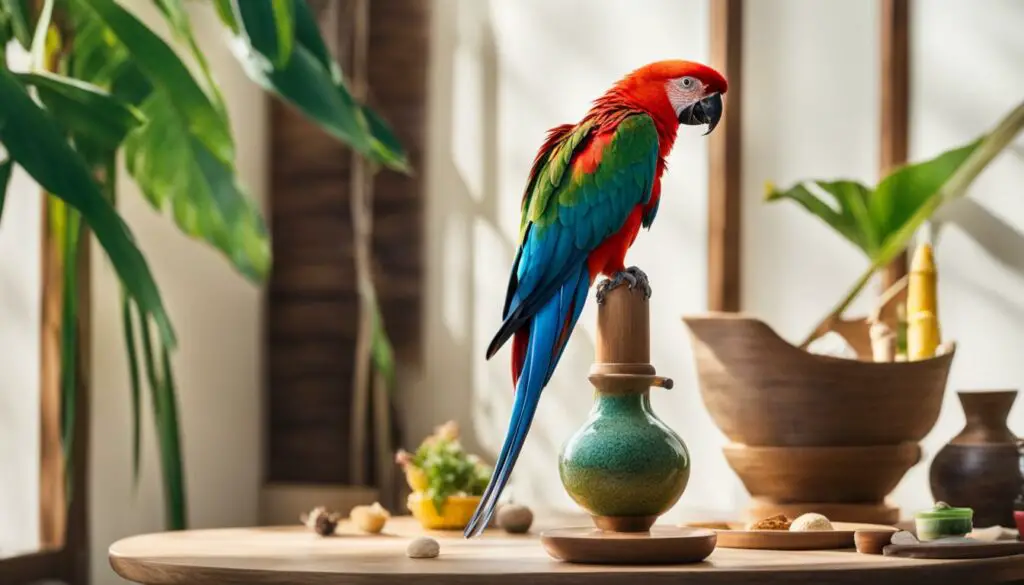
Table: Recommended Training Supplies
| Training Supplies | Purpose |
|---|---|
| Treats | Positive reinforcement and motivation |
| Clicker | Clear communication and marking desired behaviors |
| Hand-held perch | Aiding in step-up and other training commands |
Summary:
Creating a positive training environment for your parrot is essential for successful training sessions. Set up a quiet and comfortable space where your parrot can focus and learn. Gather the necessary training supplies like treats, a clicker, and a hand-held perch to provide positive reinforcement and clear communication. Remember to use rewards and be consistent in your approach to keep your parrot motivated and engaged.
Starting Early and Training Often
When it comes to parrot training, starting early and training often are key factors in ensuring success. Early training allows your parrot to develop essential skills and behaviors from a young age, setting a solid foundation for future learning. By incorporating frequent training sessions into your routine, you can reinforce these behaviors and continue to expand your parrot’s abilities.
Consistency is crucial when it comes to parrot training. By establishing a regular training schedule and sticking to it, you provide your parrot with clear expectations and a structured learning environment. This consistency helps your parrot to understand what is expected of them and reinforces their understanding of the training process.
During your training sessions, remember to keep them short and focused. Parrots have short attention spans, so it’s important to keep the sessions engaging and avoid overwhelming them with too much information at once. By breaking the training down into smaller, manageable tasks, you can ensure that your parrot stays motivated and interested in the learning process.
| Key Points | Benefits |
|---|---|
| Starting early | Builds a strong foundation for learning |
| Frequent training sessions | Reinforces behaviors and expands abilities |
| Consistency | Provides clear expectations and structure |
Example Training Schedule
- Morning: 10 minutes of basic commands and target training
- Afternoon: 5 minutes of vocalization exercises and clicker training
- Evening: 10 minutes of trick training and socialization
Remember, every parrot is unique, so adapt the training routine to suit your parrot’s individual needs and preferences. With early training, frequent sessions, and consistency, you can set your parrot up for success and enjoy a rewarding training journey together.
Teach the “Step Up” Command
One of the essential commands to teach your parrot is the “step up” command. This command not only helps with bonding but also serves as a foundation for other training exercises. By training your parrot to step onto your finger or a hand-held perch on command, you establish trust and set the stage for further training success.
To begin teaching the “step up” command, create a positive and comfortable environment for your parrot. Use a quiet room with minimal distractions, and have some of their favorite treats on hand as rewards. Position your hand or the perch in front of your parrot and say “step up” in a clear and commanding tone. Be patient and give your parrot time to process the command before rewarding them with a treat and praise when they comply.
Consistency is key when teaching the “step up” command. Practice the command daily in short training sessions, gradually increasing the duration as your parrot becomes more comfortable. Use positive reinforcement techniques such as treats, praises, and gentle petting to motivate your parrot to perform the desired behavior. As your parrot becomes more proficient in stepping up, you can introduce the command in different environments to reinforce their training.
| Tips for Teaching the “Step Up” Command |
|---|
| 1. Start training in a quiet, distraction-free environment. |
| 2. Use a clear and commanding tone when giving the “step up” command. |
| 3. Reward your parrot with treats, praises, and gentle petting for compliance. |
| 4. Practice the command daily in short training sessions to build consistency. |
| 5. Gradually introduce the command in different environments to reinforce training. |
Remember that each parrot learns at their own pace, so be patient and adapt your training approach to suit their individual needs. With time and consistency, your parrot will master the “step up” command and be ready to move on to more advanced training exercises.

Incorporating Clicker Training
Clicker training is a popular and effective technique for training parrots. By using a small handheld device that emits a distinct clicking sound, you can mark desired behaviors and provide immediate rewards. The clicker serves as a clear and consistent signal that tells your parrot when they have done something right. This method of training has several benefits that can enhance your parrot’s learning experience.
One of the main advantages of clicker training is that it allows for precise and timely reinforcement. Unlike verbal cues or physical rewards, the clicker provides an instant sound that lets your parrot know exactly what they have done correctly. This immediate feedback helps reinforce the desired behavior, making it more likely to be repeated in future training sessions.
Another benefit of clicker training is that it helps to establish a strong and positive bond between you and your parrot. The clicker becomes a unique and special sound that is associated with rewards and good things. Your parrot will begin to anticipate the sound of the clicker and will become more engaged and eager to participate in training exercises.
Clicker training can be used to teach a variety of behaviors and tricks, from simple commands like “step up” to more complex tasks. The key is to break down the desired behavior into small, achievable steps and reinforce each step with the clicker and a reward. With patience and consistency, your parrot will quickly learn new behaviors and commands through this positive reinforcement method.
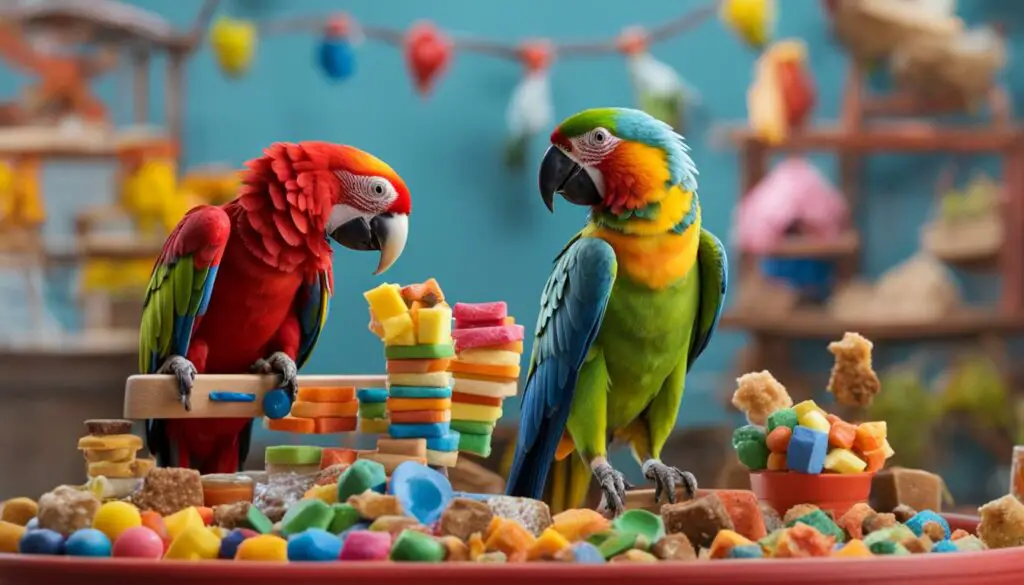
Benefits of Clicker Training
- Clear and precise communication: The clicker provides a consistent signal that tells your parrot when they have performed the desired behavior correctly.
- Instant reinforcement: The clicker allows for immediate rewards, reinforcing the behavior and enhancing the learning process.
- Stronger bond: Clicker training helps build a positive relationship between you and your parrot, creating trust and enthusiasm for training sessions.
- Versatility: Clicker training can be used to teach a wide range of behaviors and tricks, making it a versatile tool for parrot training.
- Enhanced learning experience: The positive reinforcement provided by the clicker makes training more enjoyable and engaging for your parrot, increasing their motivation to learn and participate.
By incorporating clicker training into your parrot’s training routine, you can effectively teach them new behaviors and strengthen your bond. Remember to start with simple commands and gradually increase the difficulty as your parrot progresses. With consistency, patience, and the use of positive reinforcement, your parrot will become a skilled communicator through clicker training.
Utilizing Target Training
Target training is a highly effective technique for teaching parrots new commands and behaviors. It involves using a target object, such as a chopstick or drumstick, to guide your parrot’s behavior. The first step is to choose a target object that is distinct and easy for your parrot to see.
To start target training, hold the target object a short distance away from your parrot and wait for them to interact with it. As soon as they touch the target, reward them with a treat or praise. Repeat this process several times, gradually increasing the distance between the target and your parrot. This helps your parrot understand that touching the target will result in a reward.
Once your parrot consistently touches the target, you can begin using it to teach specific commands. For example, you can guide your parrot to step up onto a perch by placing the target near the perch and rewarding them when they touch it. With consistent training sessions, your parrot will learn to associate the target with the desired behavior.
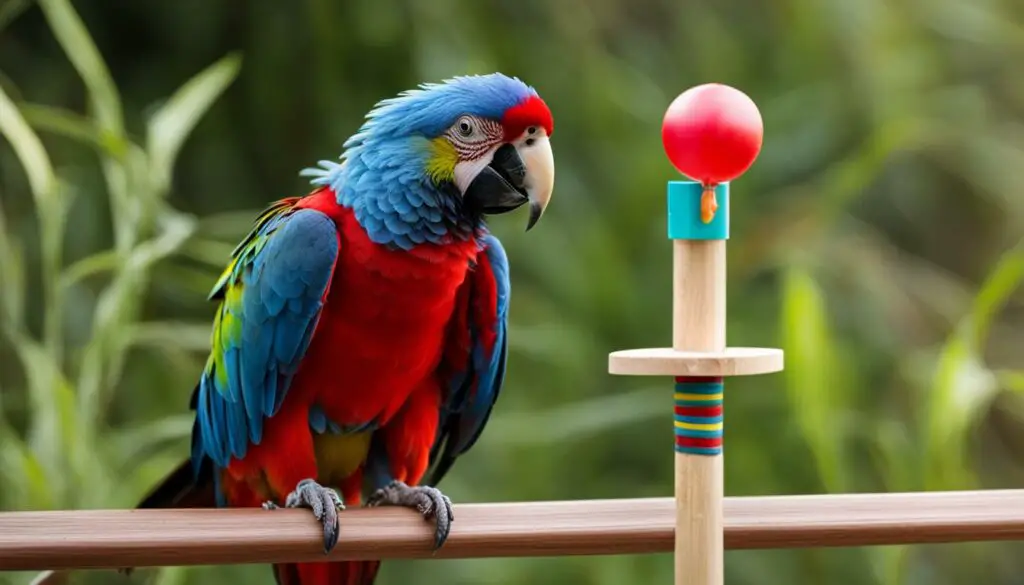
Benefits of Target Training
- Enhanced Communication: Target training helps strengthen the bond between you and your parrot by improving communication. Your parrot will learn to understand and respond to your cues, making interactions more rewarding for both of you.
- Increased Focus: Target training requires your parrot to concentrate on the target object, improving their focus and mental agility. This can be especially beneficial for highly energetic or easily distracted parrots.
- Fun and Enriching: Target training provides mental stimulation and enrichment for your parrot. It gives them a sense of accomplishment and engages their problem-solving abilities, keeping them entertained and happy.
Target training is a versatile and enjoyable training method that can be used to teach a wide range of behaviors to parrots of all ages. Incorporate this technique into your training routine to enhance your parrot’s learning experience and strengthen your bond.
Teaching Parrot Vocalizations
When it comes to teaching your parrot to talk, patience and consistency are key. By implementing effective training techniques, you can encourage your feathered friend to mimic human speech and develop a wide array of vocalizations. Here are some training methods to help you in your journey of parrot vocalization training.
Vocalization Techniques
- Spend quality time with your parrot: Regular interaction with your parrot not only strengthens the bond between you but also provides ample opportunities for vocalization. Engage in conversations, repeat phrases clearly, and encourage your parrot to mimic your words.
- Repetition is essential: Practice makes perfect, and this applies to teaching parrots to talk as well. Repeat words, phrases, and sounds consistently to help your parrot memorize and imitate them. Use positive reinforcement, such as treats and praise, to motivate your parrot during training sessions.
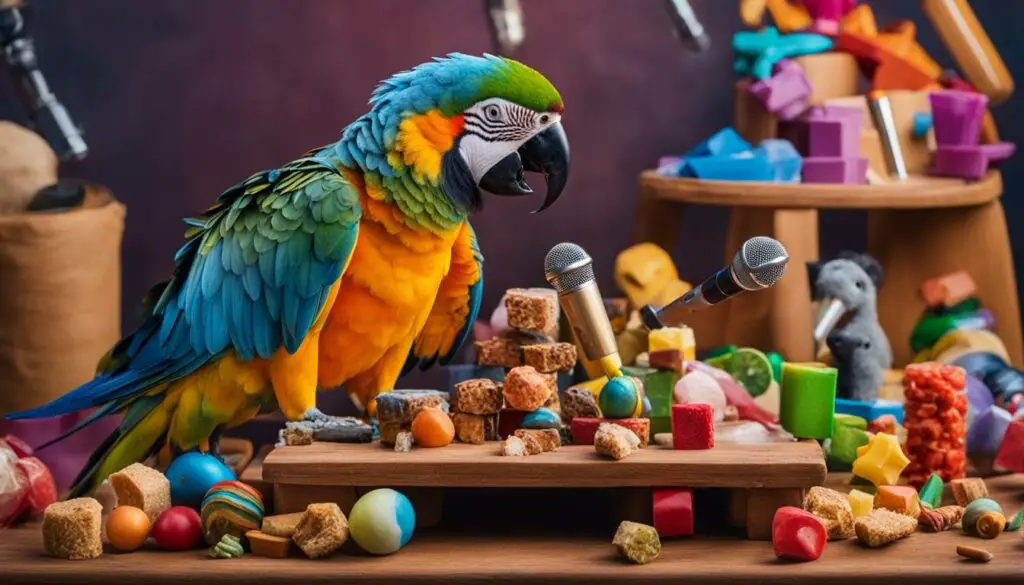
Modeling and Imitation
Parrots are excellent mimickers, and they learn by observing and imitating their surroundings. Utilize this natural inclination by creating an environment that exposes your parrot to a variety of sounds and speech patterns. Play recordings of human speech, music, or other parrot vocalizations to encourage imitation.
“Teaching your parrot to talk requires time, commitment, and a positive training environment. Remember to be patient and celebrate even small progress. With consistent training and a loving approach, you can help your parrot develop its vocal prowess.”
To summarize, teaching parrot vocalizations involves spending quality time with your parrot, using repetition as an essential tool, and creating a modeling and imitation-friendly environment. The key is to be consistent, patient, and provide positive reinforcement. With these techniques, you can unlock your parrot’s potential for talking and enjoy meaningful conversations with your feathered companion. Keep in mind that not all parrots will have the same aptitude for speech, and it’s important to respect your parrot’s individual abilities and limitations.
Fostering a Positive Relationship
Building a strong and positive relationship with your parrot is the foundation for successful training. When your parrot feels safe, loved, and bonded with you, they will be more motivated to learn and engage in training exercises. Here are some key strategies for building trust, bonding, and creating a positive parrot-human relationship:
1. Spend Quality Time Together
To foster a positive relationship with your parrot, dedicate daily quality time for interactive and bonding activities. Engage in gentle play, provide physical affection, and talk to your parrot in a calm and soothing voice. This regular interaction helps strengthen the bond between you and your feathered companion.
2. Learn Their Body Language
Understanding your parrot’s body language is crucial for effective communication and building trust. Observe their behavior, such as fluffed feathers indicating contentment or raised wings signaling excitement. This knowledge allows you to respond appropriately and build mutual understanding.
3. Reward and Reinforce Positive Behavior
Positive reinforcement is essential for promoting desired behaviors and strengthening the bond with your parrot. Use treats, praise, and gentle petting as rewards for good behavior during training sessions and throughout your daily interactions. This positive reinforcement creates a positive association with you and encourages your parrot to continue engaging in desired behaviors.
| Building Trust with Your Parrot | Bonding with Your Parrot | Creating a Positive Parrot-Human Relationship |
|---|---|---|
| 1. Spend Quality Time Together | 1. Spend Quality Time Together | 1. Spend Quality Time Together |
| 2. Learn Their Body Language | 2. Learn Their Body Language | 2. Learn Their Body Language |
| 3. Reward and Reinforce Positive Behavior | 3. Reward and Reinforce Positive Behavior | 3. Reward and Reinforce Positive Behavior |
Remember, building a positive relationship with your parrot takes time, patience, and consistency. Be gentle, understanding, and always respect your parrot’s boundaries. With a strong bond and trust, your parrot will eagerly participate in training exercises and enjoy a fulfilling relationship with you.
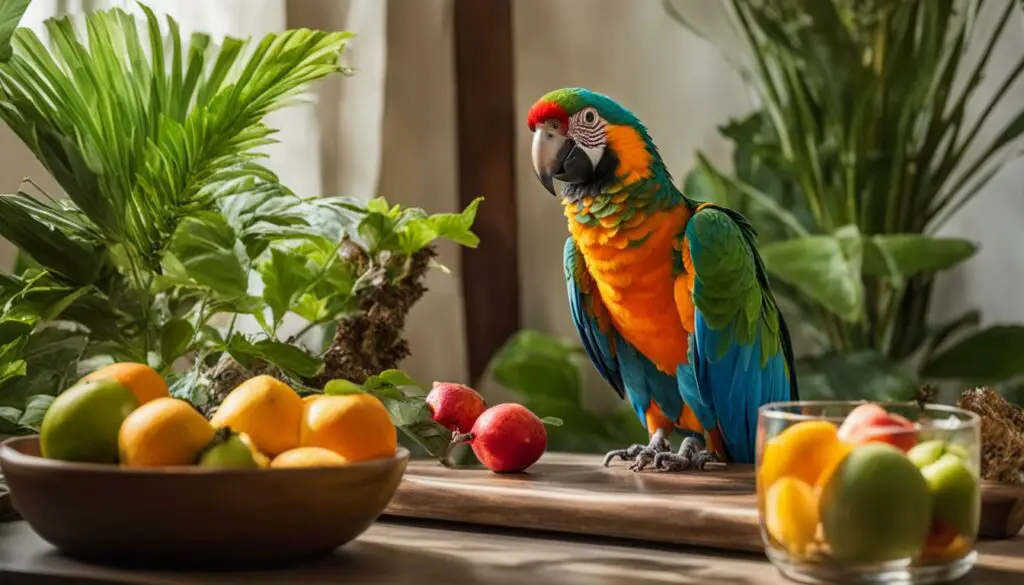
Troubleshooting Common Challenges
During the parrot training process, various challenges and behavioral issues may arise. It’s important to identify and address these problems effectively to ensure successful training outcomes. Here are some common challenges you may encounter and strategies for overcoming them:
Behavioral Issues
Parrots, like any other pets, can exhibit unwanted behaviors such as biting, screaming, or feather plucking. These behaviors may stem from various causes including fear, boredom, or lack of socialization. To address these issues, it’s crucial to understand the underlying reasons behind your parrot’s behavior and take appropriate steps to modify it.
“Understanding the root cause of your parrot’s behavioral issues is key to finding solutions. Patience, consistency, and positive reinforcement are essential when addressing these challenges.”
Implementing techniques such as positive reinforcement, environmental enrichment, and socialization can help redirect your parrot’s behavior towards more desirable actions. Providing mental stimulation through interactive toys and engaging activities can also help alleviate any boredom or restlessness that may contribute to behavioral issues.
Training Obstacles
Training a parrot can sometimes be met with obstacles that hinder progress. These obstacles may include difficulty grasping new commands, stubbornness, or lack of motivation. To overcome these challenges, it’s important to adapt your training approach and find what works best for your parrot.
Breaking down complex commands into smaller, achievable steps can make it easier for your parrot to learn. Consistent practice, patience, and positive reinforcement are key in overcoming training obstacles. Additionally, finding the right motivators for your parrot, such as their favorite treats or toys, can help keep them engaged and focused during training sessions.
| Common Challenges | Strategies for Overcoming |
|---|---|
| 1. Biting | Redirect the behavior with a command like “step up” and reward positive interactions. |
| 2. Screaming | Identify the cause of the screaming and address it through environmental changes or increased mental stimulation. |
| 3. Feather plucking | Consult with a veterinarian to rule out any underlying health issues and provide your parrot with appropriate toys and activities to alleviate stress. |
| 4. Difficulty learning new commands | Break down commands into smaller steps, provide clear cues, and use positive reinforcement to encourage learning. |
Remember, each parrot is unique, and it’s important to tailor your training methods to suit their individual needs and abilities. With patience, consistency, and a positive approach, you can overcome common challenges and achieve successful parrot training.
Providing Mental Stimulation
Your parrot’s mental stimulation is essential for their overall well-being and cognitive development. Engaging them with a variety of toys, puzzles, and enrichment activities can keep them entertained, prevent boredom, and encourage continued learning. Here are some ways you can provide mental stimulation for your parrot:
1. Interactive Toys
Invest in interactive toys that require your parrot to problem-solve and manipulate objects to access treats or rewards. These toys can include foraging puzzles, treat-dispensing toys, or toys that encourage exploration and play. Not only do they provide mental stimulation, but they also keep your parrot physically active.
2. Puzzle Boards
Introduce puzzle boards that challenge your parrot’s cognitive abilities. These boards typically have various compartments or slots where your parrot has to figure out how to retrieve hidden treats. Puzzle boards not only exercise their problem-solving skills but also provide a fun and engaging activity.
3. Training Sessions
Incorporate mental stimulation into your parrot’s daily training sessions. Teach them new tricks, commands, or behaviors that require them to think and learn. This not only stimulates their brain but also strengthens your bond with them through positive interactions and communication.
4. Rotating Toys
Rotate your parrot’s toys regularly to keep their environment fresh and exciting. Introduce new toys and remove old ones to prevent boredom and encourage exploration. This helps maintain their interest and engagement, ensuring they stay mentally stimulated.
Remember to observe your parrot’s preferences and adjust the level of difficulty of the activities accordingly. Providing mental stimulation is crucial for their overall happiness and mental well-being. By incorporating these activities into their daily routine, you can help ensure that they lead a fulfilled and enriching life.
| Toy Type | Description |
|---|---|
| Foraging Puzzles | These toys require your parrot to find and manipulate hidden treats or toys within compartments or puzzle structures. |
| Treat-Dispensing Toys | These toys dispense treats as your parrot interacts with them, stimulating their problem-solving skills and rewarding them for their effort. |
| Puzzle Boards | Puzzle boards contain various compartments or slots where your parrot needs to figure out how to retrieve hidden treats, providing a fun and engaging mental challenge. |
| Interactive Play Stands | These play stands feature movable parts, bells, and mirrors, encouraging your parrot to explore, play, and interact, providing both mental and physical stimulation. |
Maintaining Consistency
Consistency is key when it comes to parrot training. By maintaining a regular training routine and providing consistent reinforcement, you can maximize the effectiveness of your training sessions and ensure long-term success with your parrot.
The importance of consistency
Consistency in parrot training is crucial because it helps your parrot understand and remember the desired behaviors. When you consistently reinforce these behaviors, your parrot learns to associate them with positive outcomes, such as treats or praise. This reinforcement strengthens the neural pathways in your parrot’s brain, making it easier for them to understand and perform the desired actions.
Consistency also helps establish a clear communication system between you and your parrot. By consistently using the same cues, commands, and rewards, you create a predictable training environment that allows your parrot to understand what is expected of them.
Creating a training routine
To maintain consistency in your training, it’s important to establish a regular training routine. Set aside dedicated time each day for training sessions, preferably during a time when your parrot is most alert and receptive. Consistency in the timing and duration of these sessions helps your parrot develop a routine and understand that training is a regular part of their day.
When planning your training routine, consider the specific goals you want to achieve with your parrot. Break down these goals into smaller, achievable steps and focus on one behavior at a time. By setting clear objectives and progressing gradually, you can maintain consistency and build upon your parrot’s previous successes.
Consistent reinforcement
Consistent reinforcement is essential in parrot training. Whenever your parrot exhibits the desired behavior, provide immediate and consistent rewards, such as a small treat or enthusiastic praise. This reinforcement helps reinforce the connection between the behavior and the positive outcome, encouraging your parrot to repeat the behavior in the future.
Remember to be consistent not only with rewards but also with the cues and commands you use. Use the same verbal or visual cues consistently and reinforce them with the appropriate rewards. Consistency in your training approach helps eliminate confusion and allows your parrot to focus on learning and performing the desired behaviors.
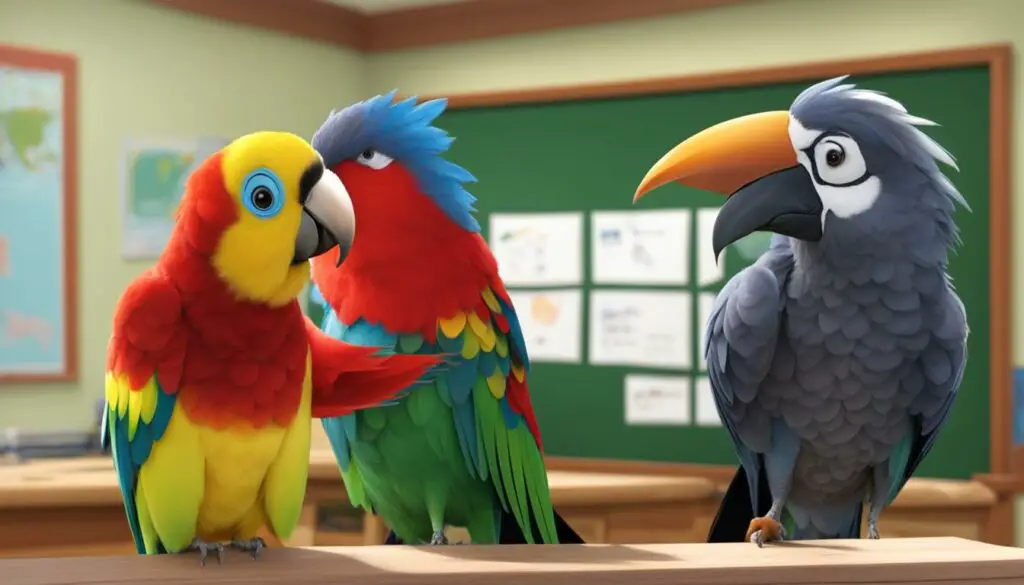
Summary
Maintaining consistency in your parrot training is crucial for effective communication and long-term success. By establishing a regular training routine and providing consistent reinforcement, you can help your parrot understand and remember the desired behaviors. Remember to break down your training goals into achievable steps and focus on one behavior at a time. With patience, dedication, and consistency, you and your parrot can achieve remarkable results in your training sessions.
Ensuring a Safe Training Environment
When it comes to training your parrot, safety should always be a top priority. Taking necessary precautions and creating a secure training environment will help prevent accidents or injuries to your feathered friend. Here are some essential tips to ensure a safe training experience:
Proper Handling Techniques
Learning the correct way to handle your parrot is crucial for both your safety and theirs. Always approach your parrot calmly and with a gentle approach. Avoid grabbing or squeezing their body and wings, as this can cause stress and harm to their delicate feathers. Instead, use a firm yet gentle grip when holding your parrot, supporting their body and allowing them to feel secure.
Safeguarding the Training Area
Before beginning a training session, make sure the area is free from potential hazards. Remove any toxic plants, chemicals, or objects that could be harmful to your parrot. Cover windows and mirrors to prevent collisions, and secure any loose cords or electrical wires that could pose a danger. Ensuring a clean and clutter-free training space will provide a safe environment for your parrot to learn and explore.
Supervision and Observation
During training sessions, it’s important to closely supervise your parrot to monitor their behavior and ensure their safety. Keep a watchful eye on their body language and reactions to training cues. If your parrot seems stressed or uncomfortable, it’s essential to pause the training and assess the situation. Remember, each parrot is unique, and some may take longer to adjust to certain training techniques.
Training Progression and Patience
While training your parrot, it’s crucial to progress at their pace and avoid rushing or forcing them into uncomfortable situations. Patience is key when it comes to parrot training, and pushing them too hard can lead to stress and potential injury. Celebrate small milestones and always reward positive behaviors to encourage your parrot’s confidence and motivation to learn.
| Important Safety Tips for Parrot Training |
|---|
| Use positive reinforcement techniques to encourage desired behaviors. |
| Never leave your parrot unattended during training sessions. |
| Introduce new training exercises gradually to prevent overwhelming your parrot. |
| Avoid using harsh corrections or punishment during training. |
| Provide a safe and comfortable resting area for your parrot to retreat to after training sessions. |
By following these safety guidelines and maintaining a secure training environment, you can ensure a positive and successful training experience for both you and your parrot. Remember, building a bond of trust and respect with your parrot is just as important as teaching them commands and behaviors.
Progressing to Advanced Training Techniques
As you and your parrot become more comfortable with the basic training methods, it’s time to progress to more advanced techniques that will challenge your feathered friend. These advanced training methods will not only continue to stimulate your parrot mentally but also strengthen the bond between you and your pet. Let’s explore some of these techniques and commands.
Teaching Complex Behaviors
One way to advance your parrot’s training is to start teaching complex behaviors. This can include actions like retrieving objects, opening and closing doors, or performing tricks. Break down these behaviors into smaller steps that your parrot can easily understand and reward them for successful completion of each step. Patience and consistency are key during this process.
Incorporating Target Training for Precision
Target training can be taken to a more advanced level by incorporating precision and accuracy into your parrot’s actions. You can train your parrot to touch specific targets or perform actions based on visual or auditory cues. This type of training enhances focus, coordination, and problem-solving abilities in your parrot.
Introducing Advanced Vocal Commands
Once your parrot has mastered basic vocalization, you can start introducing more complex words and phrases. Expand their vocabulary by teaching them specific commands or even songs. Use positive reinforcement and repetition to reinforce these advanced vocalizations.
| Advanced Training Techniques | Key Benefits |
|---|---|
| Free Flight Training | Enhances physical fitness and provides mental stimulation |
| Problem-Solving Games | Stimulates cognitive abilities and promotes independent thinking |
| Agility Training | Improves coordination, flexibility, and overall physical well-being |
“Training your parrot to perform advanced behaviors not only keeps them mentally engaged but also strengthens your bond and deepens the trust between you. Remember to always use positive reinforcement, be patient, and celebrate your parrot’s progress along the way.” – Parrot Training Expert
As you progress through these advanced training techniques, keep in mind that every parrot is unique and may progress at different rates. Tailor the training to suit your parrot’s individual needs and abilities, and always prioritize their safety and well-being. With dedication and consistency, you and your parrot can achieve remarkable results in their training journey.
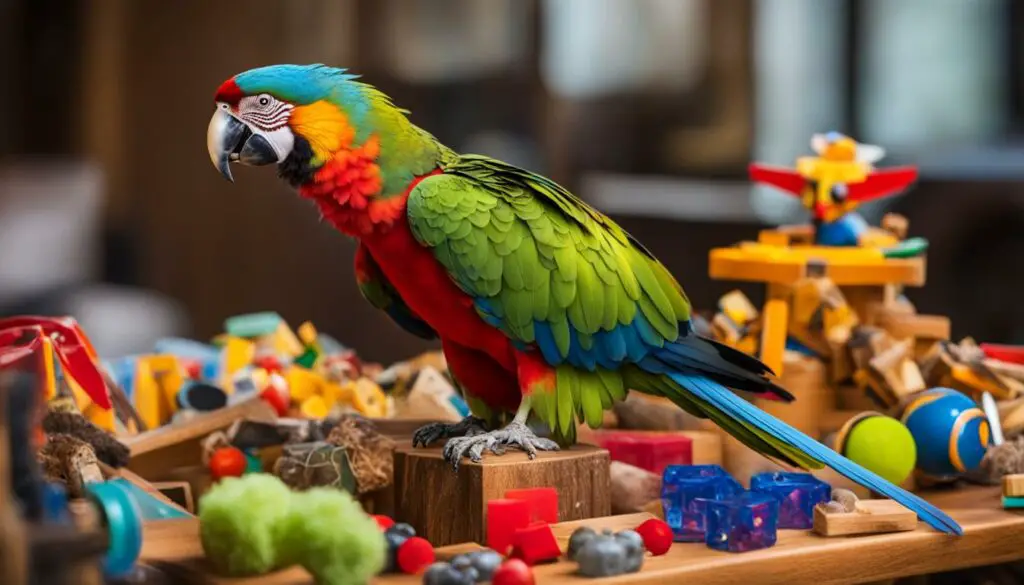
Conclusion
By following the expert parrot training methods outlined in this comprehensive guide, you can achieve successful parrot talking training and establish effective communication with your feathered friend. Throughout the training process, remember to be patient, consistent, and prioritize positive reinforcement.
Understanding parrot behavior, creating a positive training environment, and starting early with frequent training sessions are key foundations for success. Teach your parrot the essential “step up” command, incorporate clicker training and target training for better results.
Additionally, focus on teaching your parrot vocalizations using repetition, positive reinforcement, and modeling techniques. Foster a positive relationship with your parrot by building trust, bonding, and providing social interactions. Troubleshoot common challenges and address behavioral problems to overcome training obstacles.
Maintaining consistency in your training approach, providing mental stimulation, ensuring a safe training environment, and progressing to advanced training techniques will further enhance your parrot’s learning and communication abilities. By implementing these strategies, you can become an expert in parrot training and enjoy the benefits of effective parrot communication.
FAQ
What is parrot talking training?
Parrot talking training is the process of teaching a parrot to vocalize and mimic human speech, allowing them to communicate with their owners.
What are some key tips for understanding parrot behavior and communication?
It’s important to learn to interpret your parrot’s body language and vocalizations to better understand their needs and emotions.
How can I create a positive training environment for my parrot?
To create a positive training environment, gather the necessary supplies, such as treats and a clicker, and find a quiet and comfortable space for training sessions.
When should I start training my parrot?
It’s best to start training your parrot as early as possible to establish a consistent routine and help them develop the necessary skills and behaviors.
How can I teach my parrot the “step up” command?
Use positive reinforcement and shaping techniques to encourage your parrot to step onto your finger or a hand-held perch when prompted.
What is clicker training and how can I incorporate it into my parrot’s training?
Clicker training involves using a clicker to mark desired behaviors and provide immediate rewards. Learn how to effectively use a clicker in your training sessions.
What is target training and how can it benefit my parrot’s training?
Target training involves using a target object to guide your parrot’s behavior. Learn how to use target training to teach new commands and behaviors to your parrot.
How can I teach my parrot to talk and mimic human speech?
Repetition, positive reinforcement, and modeling techniques can be used to encourage vocalization and teach your parrot to mimic human speech.
How can I build a positive relationship with my parrot during training?
Building trust, providing social interactions, and creating a bond with your parrot are essential for successful training and a positive relationship.
What should I do if I encounter common challenges or behavioral issues during training?
Identify potential problems and learn effective strategies to overcome them, addressing common challenges and behavioral issues that may arise during the training process.
How can I keep my parrot mentally stimulated during training?
Provide engaging toys, puzzles, and enrichment activities to keep your parrot mentally stimulated, preventing boredom and encouraging continued learning.
Why is consistency important in parrot training?
Maintaining a regular training routine and consistently reinforcing desired behaviors are crucial for your parrot’s success and training outcomes.
How can I ensure a safe training environment for my parrot?
Follow proper handling techniques, provide a secure training environment, and prioritize safety to prevent accidents or injuries to your parrot during training sessions.
What should I do once my parrot has mastered the basics?
Once your parrot has mastered the basics, you can progress to more advanced training techniques and commands to further challenge and engage your parrot.
How can I successfully teach my parrot to talk using the methods outlined in this guide?
By following the comprehensive training methods outlined in this guide, which include patience, consistency, and positive reinforcement, you can effectively teach your parrot to talk and enhance communication with them.

